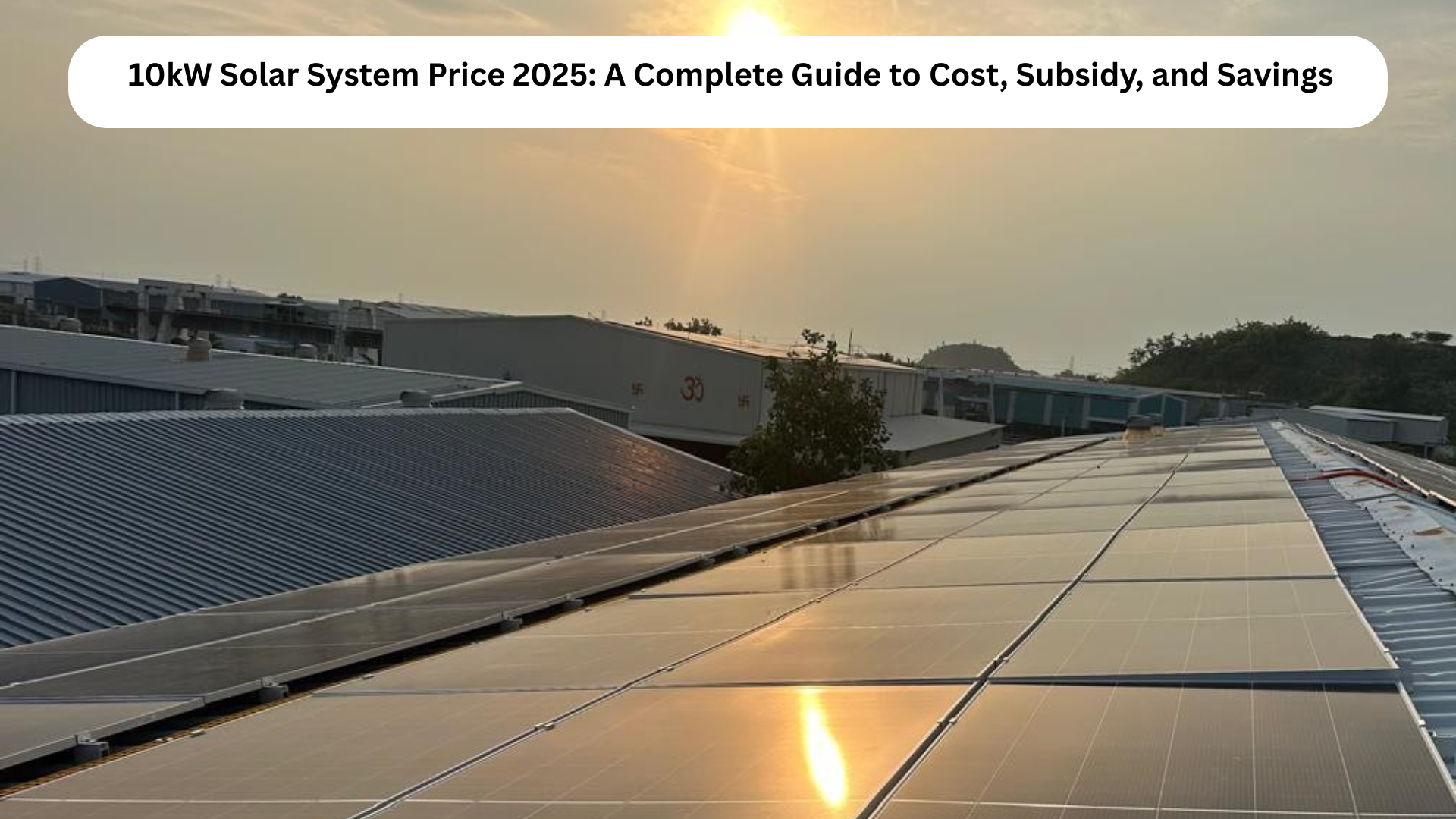Tired of opening your electricity bill and feeling a sense of dread? If you have a large home, run multiple air conditioners, or perhaps even charge an electric vehicle, you’ve likely seen your monthly bill skyrocket to ₹8,000, ₹10,000, or even ₹15,000. It’s a significant monthly expense, and it only seems to be going up.This is precisely why you’re here. You’ve probably typed “10kw solar panel price” into Google, looking for a solution. You’re wondering if a 10kW solar system is the answer to breaking free from those crippling bills.
You’re on the right track, but let’s be honest: just knowing the “panel price” is like asking for the price of an engine when you want to buy a car. It’s only one part of a much bigger picture.
Key Takeaways (TL;DR)
- Who is it for? A 10kW system is perfect for homes with monthly bills over ₹8,000 or heavy appliance use (like 2-3 ACs).
- What’s the Price? An on-grid 10kW system costs ₹5,50,000 to ₹7,00,000 before subsidy.
- How much Subsidy? Under the PM Surya Ghar Yojana, you get a fixed maximum subsidy of ₹78,000 for any system 3kW or larger.
- What’s the Final Cost? After subsidy, your final investment is approximately ₹5.7 lakhs.
- What are the Savings? It generates ~40 units/day, saving you ~₹1,15,000 per year.
- What’s the Payback? You get your money back in less than 5 years.
This guide is different. We’re going to walk you through everything you need to know, just as a trusted consultant would. We’ll cover the real all-inclusive cost, break down the different types, demystify the subsidy, and calculate the most important number: your payback period.
Is a 10kW Solar System Even Right for You? | Understanding 10kW Solar Panel Price and Benefits in India 2025
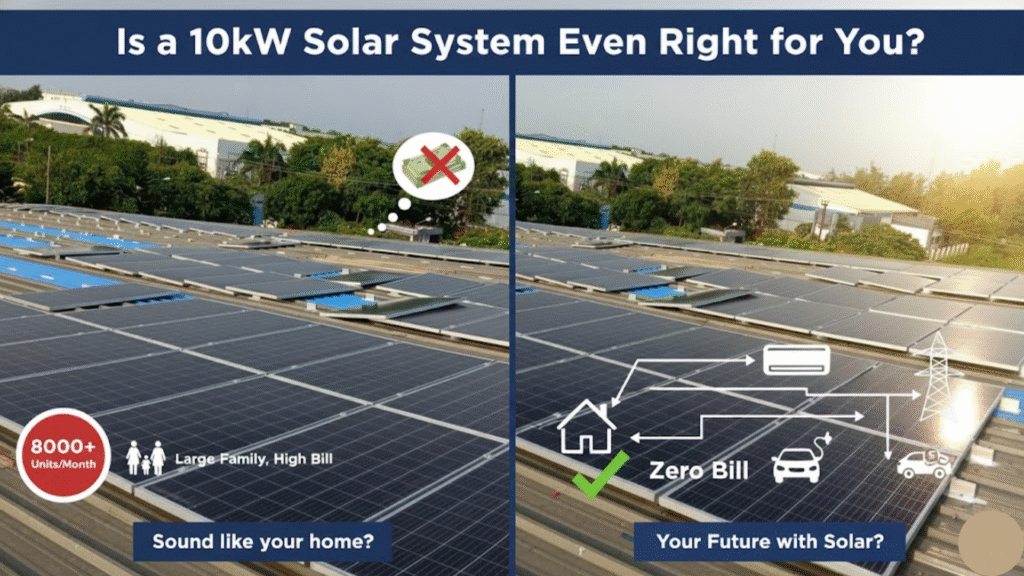
Before we talk numbers, let’s figure out if a 10kW (10,000-watt) system is the right size. A system that’s too big is a waste of money, and one that’s too small won’t solve your problem.
A 10kW system is generally a perfect fit if you check these boxes:
- Large Homes: Typically, homes with 5+ bedrooms, multiple floors, or a large joint family.
- High-Consumption Lifestyles: If your monthly electricity bill is consistently above ₹8,000.
- Heavy Appliance Usage: You regularly run 2-3 ACs, a water motor, a washing machine, multiple refrigerators, or an EV charger.
- Small Businesses: This system size is also ideal for small offices, shops, or workshops with significant daytime power usage.
A 10kW system generates approximately 40 to 45 units (kWh) of electricity per day, which is more than enough to cover this heavy load.
The Big Question: What is the 10kw solar panel price in 2025?

Here is the most important takeaway: There is no single price for a 10kW system. The final cost depends entirely on the type of system you choose.
Let’s break down the three types of solar systems and their 2025 costs.
1. The On-Grid / Grid-Tied 10kw solar panel price (The Popular Choice for Homes in India 2025)
This is the most common and most recommended system for homes and businesses in cities.
- How it Works: It’s connected to your home and the main electricity grid. It does not use batteries.
- During the Day: Your house runs on solar. Extra electricity is “exported” to the grid.
- At Night: You “import” power from the grid as usual.
- The Result: Your bill is only for the net amount of electricity used (Imported – Exported). This is called Net Metering.
Estimated Cost (All-Inclusive):
The total cost for a 10kW on-grid solar system in 2025 is:
Price Range: ₹5,50,000 to ₹7,00,000
This price difference depends on the brand of panels (e.g., Mono PERC vs. Bifacial) and the inverter you choose.
2. The Off-Grid System (Total Independence)
This system is for people who want to be completely disconnected from the grid.
- How it Works: This system is not connected to the grid. It generates power and stores it in a large battery bank.
- Best For: Remote farmhouses, rural areas with no grid access, or places with extreme power cuts.
- The Catch: Batteries are the most expensive part. A battery bank for a 10kW load is very, very expensive.
Estimated Cost (All-Inclusive):
Price Range: ₹9,00,000 to ₹14,00,000+
3. The Hybrid System (The Best of Both Worlds)
A hybrid system gives you the reliability of the grid and the security of battery backup.
- How it Works: It’s an on-grid system with a special hybrid inverter and a smaller battery pack.
- Normal Days: It works just like an on-grid system (Net Metering).
- During a Power Cut: It instantly switches to its battery, allowing you to run “critical loads” (lights, fans, Wi-Fi).
Estimated Cost (All-Inclusive):
Price Range: ₹7,50,000 to ₹10,00,000
Quick Comparison Table
Here is a simple table to help you decide.
| System Type | Price Range (10kW) | Best For | Subsidy Available? |
| On-Grid | ₹5,50,000 – ₹7,00,000 | Cities (Reliable Grid) | Yes |
| Hybrid | ₹7,50,000 – ₹10,00,000 | Cities (Frequent Cuts) | Yes |
| Off-Grid | ₹9,00,000 – ₹14,00,000+ | Remote Areas (No Grid) | No |
The PM Surya Ghar Yojana: How Much Subsidy Can You Actually Get?
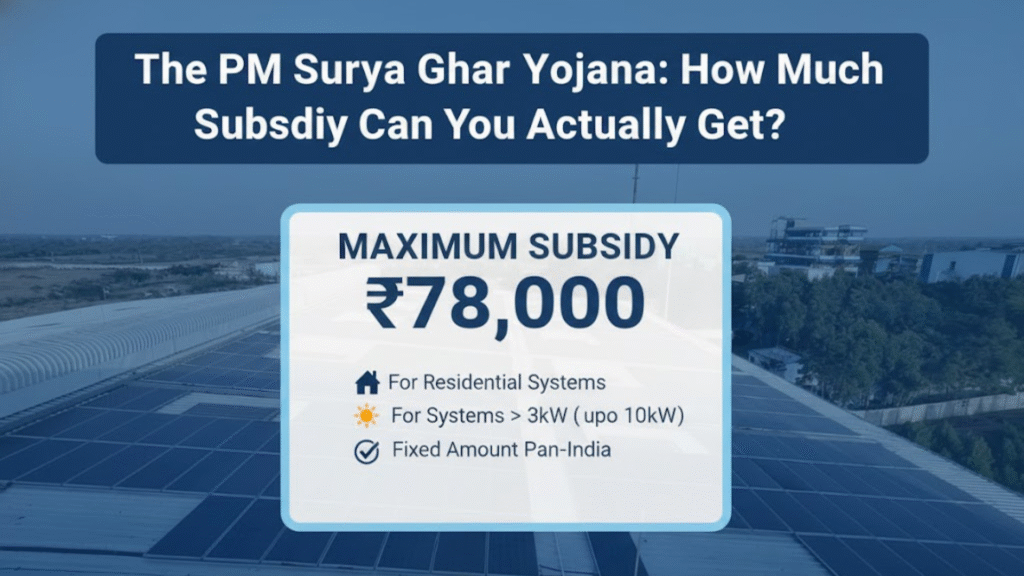
This is where most people get confused, so let’s make it simple.
Here is the official subsidy structure for 2025:
- For the first 1kW: ₹30,000
- For the second 1kW: ₹30,000
- For the third 1kW: ₹18,000
- For systems above 3kW: ₹0 additional subsidy
Let’s do the math:
(1kW x ₹30,000) + (1kW x ₹30,000) + (1kW x ₹18,000) = ₹78,000
Here is the crucial part: The maximum subsidy for any residential solar system, regardless of its size, is capped at ₹78,000.
This means whether you install a 3kW system, a 5kW system, or a 10kW system, the maximum subsidy you can receive on the national portal is ₹78,000.
Your Final 10kW Solar System Cost (After Subsidy)
Let’s calculate the final price for the most popular option, the on-grid system.
- Average System Cost: ₹6,50,000
- Less: PM Surya Ghar Subsidy: – ₹78,000
- Your Final Investment: ~ ₹5,72,000
So, for a one-time investment of just under ₹6 lakhs, you are buying a 25-year asset that can wipe out your electricity bill.
The Real Numbers: Calculating Your Savings & ROI
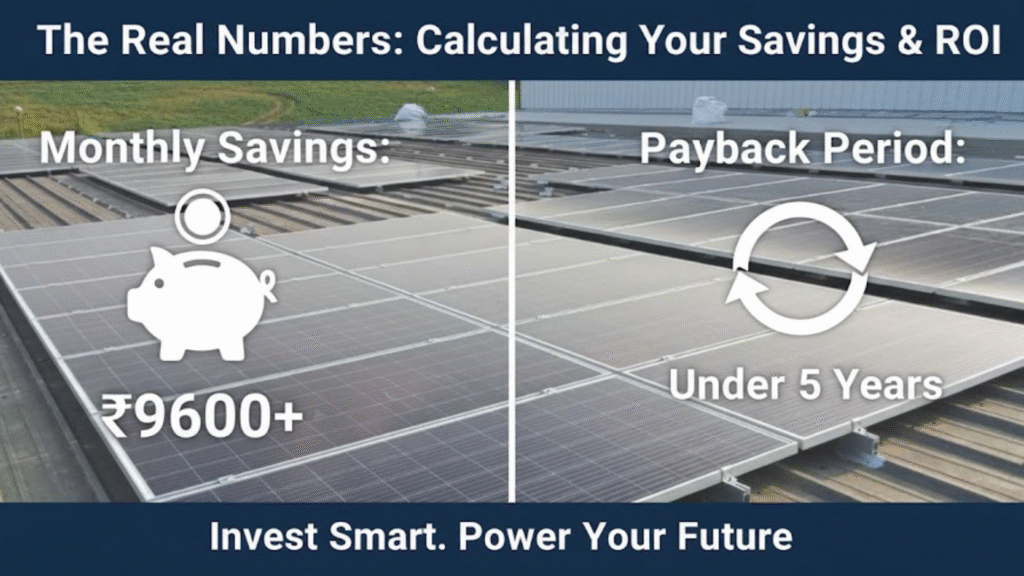
This is the most important section. This is where we justify the investment. Let’s be conservative with our numbers.
Step 1: Calculate Electricity Generation
- System Size: 10kW
- Average Daily Generation: ~40 units (it’s often 45-50, but we’ll be safe)
- Average Monthly Generation: 40 units/day x 30 days = 1,200 units
Step 2: Calculate Your Monthly Savings
Let’s assume your average electricity tariff is ₹8/unit.
- Total Value of Electricity Generated: 1,200 units x ₹8/unit = ₹9,600 per month
That’s right. Your system is a “money-making” machine that generates ₹9,600 worth of electricity every single month.
- Your Total Annual Savings: ₹9,600 x 12 months = ₹1,15,200
You will save over one lakh per year, every year.
Step 3: Calculate the Payback Period (Return on Investment)
This is the “break-even” point.
- Your Final Investment: ₹5,72,000
- Your Annual Savings: ₹1,15,200
Payback Period = Total Investment / Annual Savings
₹5,72,000 / ₹1,15,200 = 4.96 Years
In less than 5 years, your solar system has completely paid for itself.
From Year 6 to Year 25 (and beyond), every single unit of electricity it produces is 100% free profit. You are getting a guaranteed, tax-free return of over 20% on your investment.
What’s Actually Included in That Price? (A Detailed Cost Breakdown)
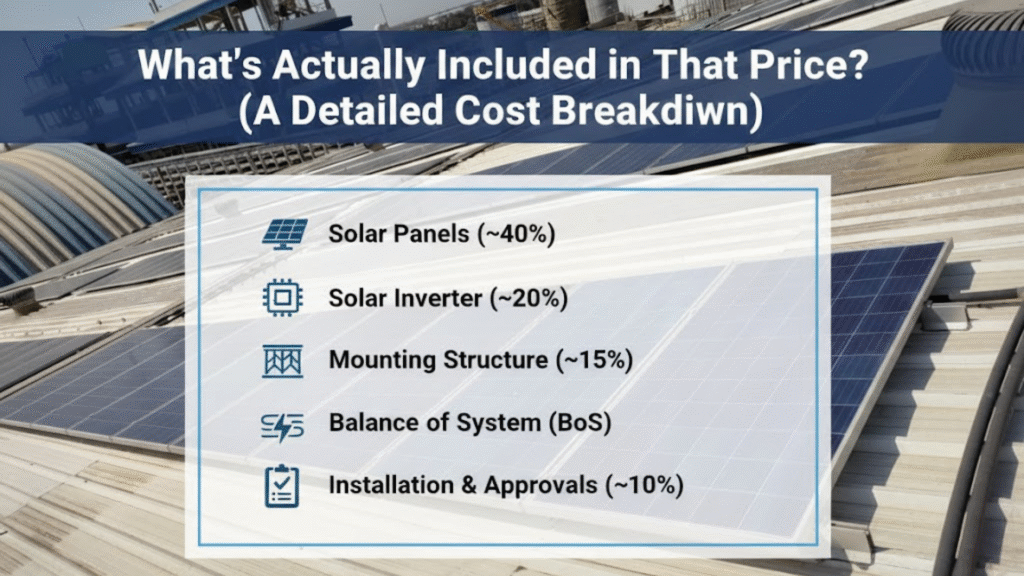
When a trustworthy company gives you a quote, it’s not just the “10kw solar panel price.” The cost is a bundle of 5 key components. This table breaks it down:
| Component | Approx. % of Total Cost | What to Look For |
| Solar Panels | ~40% | Tier-1 Brands (e.g., Waaree, Adani, Loom), 12+ yr product warranty |
| Solar Inverter | ~20% | Premium brands (e.g., Solis, SMA, Fronius), 5-10 yr warranty |
| Mounting Structures | ~15% | Anti-rust (Galvanized Iron or Aluminum), wind-speed rated (150km/h) |
| Balance of System | ~15% | High-quality UV-protected cables, safety devices (ACDB/DCDB, Earthing) |
| Installation & Approvals | ~10% | Professional engineers, all DISCOM paperwork for Net Metering |
Frequently Asked Questions (FAQ)
Here are the most common questions we get from customers considering a 10kW system.
Q1: How much roof space do I need for a 10kW system?
You will need approximately 1,000 to 1,200 square feet of shadow-free, south-facing (ideally) roof area. A professional site survey will confirm the exact area.
Q2: What happens during a power cut with my on-grid system?
For safety reasons, all on-grid systems are designed to shut down during a power cut (this is called “anti-islanding”). This prevents them from sending electricity back to the grid while workers are trying to fix it. If you need backup, you must install a Hybrid system.
Q3: What maintenance is required?
Almost none. The only maintenance is cleaning the panels every 1-2 weeks to remove dust, which you can do with a hose and a soft mop. Rain often does this for you.
Q4: What warranty should I expect?
- Solar Panels: 10-12 year product warranty, 25-30 year performance warranty.
- Inverter: 5-10 year standard warranty.
- Workmanship: A good installer will offer a 1-5 year warranty on the complete installation.
Q5: What happens on a cloudy or rainy day?
Your panels will still produce electricity, just less of it. On a very cloudy day, it might only produce 10-20% of its normal output. During that time, your house will seamlessly pull the remaining power it needs from the grid. You won’t even notice.
Q6: Can I install a 10kW system in phases, like 5kW now and 5kW later?
This is not recommended. The PM Surya Ghar subsidy is a one-time application per household. Furthermore, upgrading an on-grid system is complex; you’ll need to replace the inverter and re-do all the government paperwork. It’s much more cost-effective to install the correct size from the start.
The Final Verdict: Is a 10kW System Worth the Price in 2025?
Let’s look at the facts.
You’re currently spending over ₹1,00,000 per year on an expense (your bill) that gives you zero return.
For a one-time investment of ~₹5.7 lakhs (after the ₹78,000 subsidy), you can buy an asset that:
- Pays for itself in less than 5 years.
- Saves you over ₹1,15,000 every year after that.
- Increases the value of your property.
- Gives you 20+ years of free, clean electricity.
A 10kW solar system isn’t a “cost.” It’s one of the smartest, safest, and most profitable investments you can make for your home or business in 2025.
Ready to Ditch Your Electricity Bill?
Don’t just guess your 10kW solar panel price. Get an exact, customized quote for your home.
Call VARSHA SOLAR ELECTRIC today at visit https://www.varshasolarelectric.com/ to schedule a FREE, no-obligation site survey. Our experts will analyze your roof, check your electricity bill, and give you a detailed proposal showing your exact cost, savings, and payback period.
